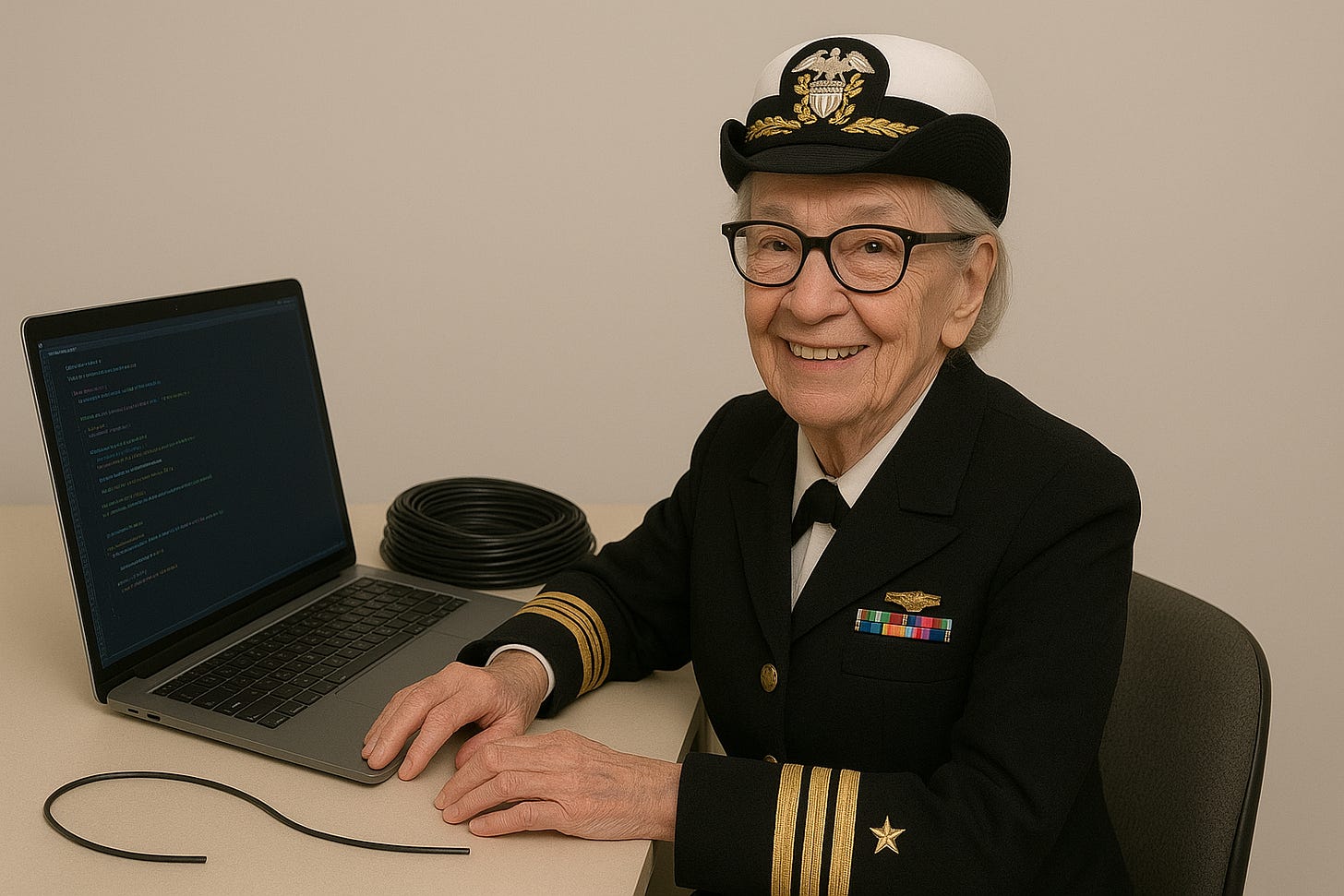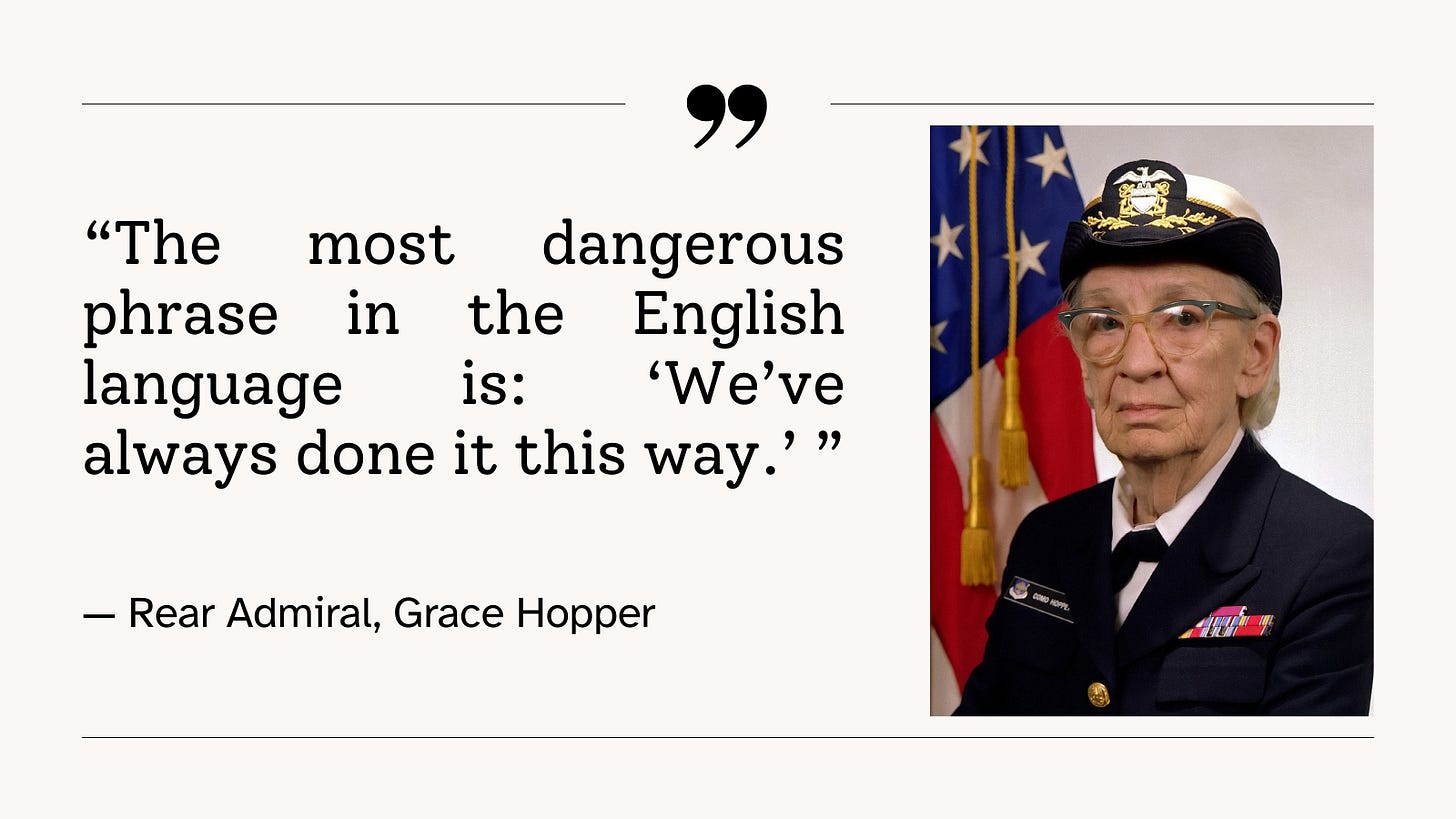Grace Hopper Would Love AI Coding
From machine code to natural language: Admiral Hopper's legacy lives on.
Admiral Grace Hopper carried wire pieces in her purse - 11.8 inches for a nanosecond, nearly 1,000 feet for a microsecond. These weren't random lengths. They represented the maximum distance electricity could travel in those tiny time fractions.
She'd hand them to confused engineers during meetings, watching their faces change as the abstract became tangible.
"I sometimes think we ought to hang one over every programmer's desk so they'll know exactly what they're throwing away when they throw away a microsecond."
But Hopper's real genius wasn't making time visible - it was making computers speak human. She spent her career fighting the assumption that humans had to adapt to machines, insisting machines should understand us.
I think about those wires and Admiral Hopper when I'm prompting Claude in plain English and watching code appear. We're living through exactly what Amazing Grace predicted.
Beyond the Model T
In 1983, when Morley Safer suggested the computer revolution was over, Hopper disagreed: "We're only at the beginning. We've got the Model T. That's where we are now."
She was right. If 1983 was the Model T, today's AI coding assistants are self-driving cars. We've gone from her Mark I computer doing three calculations per second to language models processing 100,000 tokens per second while understanding natural language.
But again, the real revolution wasn't about speed—it was about making computers accessible to human thinking.
The Vision She Fought For
When Hopper proposed English-like commands in the 1950s, colleagues said it was impossible. "I was told very quickly that I couldn't do this because computers didn't understand English."
But she had a different vision. She saw two kinds of users: "people who liked using symbols—mathematicians and people like that" and "people who were in data processing who hated symbols, and wanted words."
Her breakthrough came with FLOW-MATIC in 1955—the first programming language using English-like statements. Commands replaced cryptic symbols, and FLOW-MATIC can be understood even by today’s programmers who may have never seen it before:
COMPARE PRODUCT-NO (A) WITH PRODUCT-NO (B) ; IF GREATER GO TO OPERATION 10 ;
IF EQUAL GO TO OPERATION 5 ; OTHERWISE GO TO OPERATION 2 .But like all great languages, FLOW-MATIC’s legacy lives on in something even bigger. And that would be COBOL, introduced in 1959 as the Common Business-Oriented Language. Programming finally looked less like advanced mathematics and more like structured English.
Hopper kept pushing for actual English sentences that computers could execute.
Programming in Plain English
Today, I write to GPT-5: "Build me a React component that displays a user's profile with their avatar, name, and bio. Make it responsive and include a follow button." And it works.
This isn't sophisticated autocomplete. These models understand context, intent, and implied requirements—exactly what Hopper envisioned.
The progression is clear:
Machine code and punch cards (1940s-1950s)
Assembly language and early compilers (Hopper's era)
High-level languages like COBOL (1960s-1970s)
Personal computers, BASIC and the like (Hopper's "Model T" era)
Modern specialized high- and low- programming languages (1990s-2000s)
Natural language programming with AI (today)
We've reached Hopper's ultimate goal: the primary interface between humans and computers is natural language itself.
Making the Magic Concrete
Just like Hopper with her wires, let's make LLMs less of a black box.
Think of tokens as LEGO bricks. Each token represents roughly three-quarters of a word. When you prompt an LLM, you're giving an impossibly fast robot LEGO bricks and asking it to build something meaningful.
That robot sees up to 128,000 bricks at once—that's roughly 400-500 pages of text or about 25,000 lines of code. It processes 50-120 bricks per second depending on the model.
Put that in perspective: A fast typist at 100 words per minute produces about 133 tokens (LEGO bricks) per minute, or about 2.2 per second. Modern LLMs like Claude Sonnet 4 (50-60 TPS) or Gemini Flash (~100 TPS) process 25-50 times faster than a speed typist.
In one microsecond—the time electricity travels Hopper's 984-foot wire—the LLM processes about 0.05-0.1 tokens. A human typist needs 30-60 seconds to produce what the AI generates in one second.
In one full second? 50-120 tokens of coherent response. That's what would take a speed typist 25-60 seconds to type, but the AI is simultaneously understanding context, following instructions, and generating syntactically correct code.
This isn't magic. It's very fast pattern matching at incredible scale, constrained by the same physical laws Hopper's wires represented.
Time to Pay Attention
Admiral Hopper would agree: software engineers need to pay attention.
Too many developers make the same mistake Hopper's contemporaries made—dismissing fundamental shifts because they don't fit existing mental models. They see AI coding as "just autocomplete" or "vibe coding that won't last." Even worse, they say Hopper’s most dangerous phrase:
Hopper also understood: when you make computers more accessible to human thinking, you don't replace creativity—you amplify it.
Engineers who learned COBOL didn't become obsolete when it replaced machine code. They became more productive. The same thing is happening now, faster and more dramatically. Hopper also kept a counterclockwise clock in her office to remind people there was never any fundamental reason clocks had to run clockwise—just what people were used to.
There's no fundamental reason programming has to be about memorizing syntax and fighting compilers. That was just what we were used to.
What Would She Have Thought?
I imagine Hopper pulling out LEGO bricks instead of wires. "This is a token. Now imagine a machine that understands your entire blueprint and builds whatever you describe, as fast as electricity travels down this wire." And then pull out the LEGO Eiffel Tower. At 10,001 pieces, it would take an LLM just a minute or two to assemble. It takes humans about 15-20 hours. Thankfully, Chris Adams time-lapsed his 14 hour build to show it at LLM speed.
The parallels run deeper still:
Then: COBOL made programming readable to business people
Now: LLMs make programming accessible to anyone who can describe what they want
Then: She created the first compiler to translate human-readable code
Now: We have AI translating natural language directly into code
Then: She fought "we've always done it that way" thinking
Now: We need to challenge assumptions about what programming looks like
This isn't just about making programming easier—it's about democratizing computation itself.
Just as COBOL broke programming out of mathematicians' exclusive realm, AI is breaking it out of professional developers' exclusive realm. Product managers build prototypes. Teachers create educational tools. Kids make games by describing them.
The Wire Forward
Hopper's nanosecond wire made the abstract concrete so people could reason with it and transcend it. We need to do the same with AI coding tools.
Stop treating them as magical black boxes. Understand them as very fast pattern matchers working with discrete meaning units at incredible scale.
Grace Hopper proved human-computer relationships didn't have to be adversarial—they could be collaborative. She laid the groundwork for everything we're experiencing now.
Don’t let yourself say "we've always done it that way."
I wish she could have seen Claude write COBOL from casual English. Here’s a program that prints the scale of a nanosecond, microsecond, and second - made from the prompt “Can you write me a COBOL program that prints out a scaled length of a nanosecond and a microsecond in the output?”. Hopper would have smiled, pulled out a wire, and repeated what she told Safer: "We're only at the beginning."
To developers dismissing AI coding as a fad, I imagine her adding, "Pay attention. We've moved beyond the Model T I talked about in 1983. This is what I've been telling you would happen for sixty years."
The future is human-friendly computing.
Admiral Hopper would be proud—and she'd want you to get on board.



